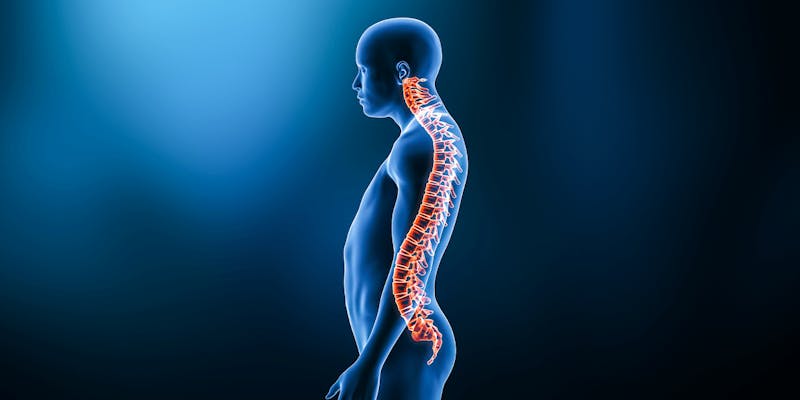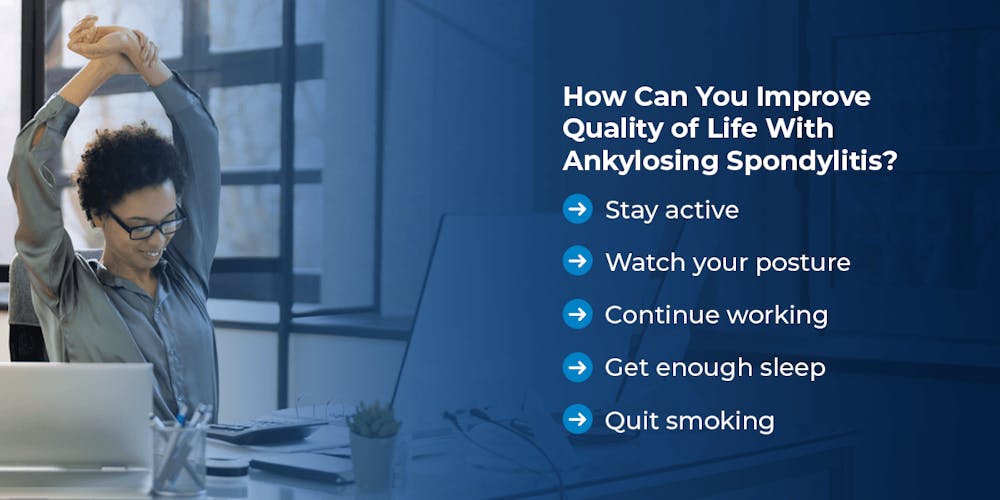
Ankylosing spondylitis (AS) is a type of arthritis that causes spinal joint inflammation. Pain and stiffness in the lower back may spread to other areas like the neck, shoulder or knees. It impacts the sacroiliac joints, where the lower spine (sacrum) meets the top back of the pelvis (ilium). Your body produces more calcium, causing bones to grow between the vertebrae. These bone bridges can cause the spine to fuse.
If you or a loved one has AS, it’s natural to feel worried. It is possible to have quality of life with ankylosing spondylitis. The proper diagnosis and treatment can help you manage the disease.
What Are the Symptoms of Ankylosing Spondylitis?
In the early stages, you may confuse AS with a simple backache. The most common symptoms are stiffness and lower back and hip pain. The pain may worsen after periods of inactivity or while sleeping. As the condition progresses, the pain may radiate to other body areas. The severity of symptoms varies. Some people experience chronic pain, while others have mild bursts.
Symptoms may include:
- Lower back pain and stiffness, which gets better with activity.
- Pain or swelling in the neck, shoulders, hips or thighs.
- Tenderness in the buttocks or the backs of the thighs.
- Soreness in the foot arch or heel.
- Skin rashes, such as psoriasis.
- Unexplained appetite or weight loss.
- Extreme tiredness even when well-rested (fatigue).
- Tightness or pain around the ribs when taking a breath.
- Vision problems resulting from an inflammatory condition called uveitis.
What Causes Ankylosing Spondylitis?
AS is an autoimmune disease in which the immune system attacks instead of protects the body. Experts are unsure of the exact cause, but it has been linked to a gene variant. Genes related to arthritis come from the human leukocyte antigen family. The human leukocyte antigen-B (HLA-B27) gene is a common denominator in many people with AS.
Who Is Most at Risk for Ankylosing Spondylitis?
Although AS can affect anyone, certain factors increase the risk of developing it:
- Age: AS typically occurs in people under 45 and may present in childhood or adolescence.
- Family history: The risk of developing AS is higher if your parents or a close relative have it.
- Gender: Men are more likely to be diagnosed with AS than women.
- Preexisting autoimmune conditions: Psoriasis, Crohn’s disease or ulcerative colitis may increase AS risk.
How to Diagnose Ankylosing Spondylitis
Since many people mistake AS for back pain, they often leave it, hoping it will resolve on its own. It’s essential to seek medical help if you have persistent back pain or suspect you may have AS. A diagnosis may include:
- Physical examination: Your doctor will ask about your symptoms, pain and family history. They will then examine your spine.
- Blood tests: Certain tests may show inflammation or mutation of the HLA-B27 gene.
- Imaging tests: Imaging scans like X-rays can show signs of arthritis.
Your primary physician may refer you to an orthopedic spine specialist or rheumatologist.
How to Treat Ankylosing Spondylitis
AS is a lifelong condition, but treatment helps manage the symptoms. Here are some of the common treatments:
- Nonsteroidal anti-inflammatory drugs (NSAIDs): Over-the-counter (OTC) NSAIDs like ibuprofen or painkillers like acetaminophen can ease inflammation and pain. You should take them for no more than 10 consecutive days.
- TNF blockers: These target an inflammatory protein called tumor necrosis factor (TNF) to help reduce pain, stiffness and swollen joints. TNF blockers can be administered via an injection under the skin or through an intravenous line.
- Corticosteroids: You need a prescription for anti-inflammatory corticosteroids. You can take cortisone as a tablet or inject it straight into the affected joints.
- Physical therapy: A combination of massage and other treatments improves mobility. This form of therapy helps relieve pain while strengthening the spine.
- Exercise: Staying active helps reduce the symptoms of AS. Sitting for long periods or remaining inactive worsens the pain. Physical activity also encourages flexibility and straightness in your spine. A physical therapist can recommend stretches and exercises for spine health.
- Surgery: Some people may need a hip or knee replacement for severe joint damage. Replacing damaged joints can alleviate pain and increase mobility. Spinal surgery uses advanced robotic technology and surgical skills for precise joint replacements.
What Are the Complications of Ankylosing Spondylitis?
AS increases the risk of spinal fractures and can lead to other complications, such as:
- Fused vertebrae: Since AS causes extra bone growth, the spine’s bones can fuse.
- Kyphosis: This is a forward curving of the spine that causes your back to become rounded.
- Osteoporosis: When the body loses bone density, it causes the bones to become brittle and weak.
- Uveitis: This condition occurs when the eye’s middle layer becomes inflamed.
- Heart conditions: AS can increase aortitis, arrhythmia or cardiomyopathy risk.
- Nerve damage: Pressure and swelling of the spinal cord can compact the lower back nerves.

How Can You Improve Quality of Life With Ankylosing Spondylitis?
There are ways you can lessen the role ankylosing spondylitis plays in your life. Medical treatments can help minimize the symptoms and manage the condition. You can also take control by doing the following:
- Stay active: Regular exercise helps manage your condition. It improves the range of movement and prevents the spine from stiffening. Gentle activities like yoga or Pilates help with strength and flexibility. Staying active is good for the heart, lungs and overall health.
- Watch your posture: AS can cause your spine to bend. Practice good posture by keeping your shoulders back and avoiding hunching.
- Continue working: AS shouldn’t prevent you from working. However, you may need to adjust your work environment, such as using an ergonomic office chair. Speak to your occupational safety or HR representative.
- Get enough sleep: AS pain can disturb sleep, but getting enough rest helps manage the pain. Try having a warm bath before bed or using a hot water bottle to soothe the area. Implement a healthy bedtime routine to help you relax.
- Quit smoking: The adverse effects of smoking on the body are well-documented. In the case of AS, it puts extra pressure on the lungs and increases the risk of heart problems. Smoking also contributes to spinal fusion.
Why Trust New York Spine Institute?
The specialists at New York Spine Institute have decades of experience treating spinal disorders. We have the expertise to help with ankylosing spondylitis, from diagnosis to treatment. Our diagnostic division uses the latest MRI and X-ray imaging for accurate diagnosis. Our expert team includes orthopedic surgeons, neurosurgeons and pain management specialists.
We combine cutting-edge technology, innovative techniques and continued research. Our specialists treat the full range of neuromusculoskeletal conditions, including ankylosing spondylitis. As New York’s top spinal and orthopedic experts, we are leaders in spine care.
Discover How Our Specialists Can Help With Ankylosing Spondylitis
We understand the impact that ankylosing spondylitis has on your life. At New York Spine Institute, our priority is helping you regain control. Our spine specialists, physical therapists and surgeons work together in your best interest. Each patient is unique, and we create customized treatment plans to meet their needs.
Contact us today to schedule an appointment or learn more about our services.

